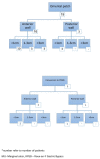Marginal Ulcer Perforation after One Anastomosis Gastric Bypass: Surgical Treatment and Two-Year Outcomes
- PMID: 38892786
- PMCID: PMC11172864
- DOI: 10.3390/jcm13113075
Marginal Ulcer Perforation after One Anastomosis Gastric Bypass: Surgical Treatment and Two-Year Outcomes
Abstract
Background: Marginal ulcer (MU) perforation is a chronic complication after One-anastomosis Gastric Bypass (OAGB). This study's purpose was to analyze patients undergoing OAGB revision due to MU perforation and describe the two-year outcomes. Methods: A retrospective analysis of a database in a single-tertiary hospital. All patients undergoing surgical revision due to MU perforation were included. Results: During the study period, 22 patients underwent OAGB revision due to MU perforation. The rate of MU perforation was 0.98%. The median age was 48 years and there were 13 men (59%). The median time from OAGB to MU perforation was 19 months with a median total weight loss of 31.5%. Nine patients (41%) were smokers. Omental patch (±primary closure) was performed in 19 patients (86%) and three patients (14%) underwent conversion to Roux-en-Y gastric bypass (RYGB). At a median follow-up of 48 months, three patients (14%) had recurrent MU diagnosis, of which one had a recurrent MU perforation. Four patients (18%) underwent conversion to RYGB during follow-up. Conclusions: MU perforation is a chronic complication after OAGB. In this cohort, most patients were men and likely to be smokers. Omental patch was effective in most cases. Recurrent MU rates at two years follow-up were acceptable.
Keywords: complications; marginal ulcer; one anastomosis gastric bypass; perforation; surgical revision.
Conflict of interest statement
The authors declare no conflicts of interest.
Figures
Similar articles
-
Similar Rates of Symptomatic Marginal Ulcers After One-Anastomosis-Gastric Bypass Compared to Roux-en-Y Gastric Bypass.Obes Surg. 2024 Jul;34(7):2331-2337. doi: 10.1007/s11695-024-07298-y. Epub 2024 May 24. Obes Surg. 2024. PMID: 38789681
-
Marginal ulcer causing delayed anastomotic perforation following one anastomosis gastric bypass (OAGB).Surg Obes Relat Dis. 2021 Feb;17(2):379-383. doi: 10.1016/j.soard.2020.09.022. Epub 2020 Sep 22. Surg Obes Relat Dis. 2021. PMID: 33268323
-
Conversion of One-Anastomosis Gastric Bypass (OAGB) to Roux-en-Y Gastric Bypass (RYGB) is Effective in Dealing with Late Complications of OAGB: Experience from a Tertiary Bariatric Center and Literature Review.J Metab Bariatr Surg. 2021 Jun;10(1):32-41. doi: 10.17476/jmbs.2021.10.1.32. Epub 2021 Jun 30. J Metab Bariatr Surg. 2021. PMID: 36687754 Free PMC article.
-
Anastomotic Gastro-Jejunal Ulcer Perforation Following One Anastomosis Gastric Bypass: Clinical Presentation and Options of Management-Case Series and Review of Literature.Obes Surg. 2020 Jun;30(6):2423-2428. doi: 10.1007/s11695-020-04423-5. Obes Surg. 2020. PMID: 32062846 Review.
-
Randomized Controlled Trial of One Anastomosis Gastric Bypass Versus Roux-En-Y Gastric Bypass for Obesity: Comparison of the YOMEGA and Taiwan Studies.Obes Surg. 2019 Sep;29(9):3047-3053. doi: 10.1007/s11695-019-04065-2. Obes Surg. 2019. PMID: 31290104 Review.
Cited by
-
Perforated Peptic Ulcer of Gastric Remnant Following One Anastomosis Gastric Bypass: Lessons We Learn From a Case.Obes Surg. 2025 Feb;35(2):379-380. doi: 10.1007/s11695-025-07676-0. Epub 2025 Jan 9. Obes Surg. 2025. PMID: 39789360 No abstract available.
-
Marginal ulcer perforation after one anastomosis gastric bypass: a case report.J Surg Case Rep. 2025 Feb 21;2025(2):rjaf073. doi: 10.1093/jscr/rjaf073. eCollection 2025 Feb. J Surg Case Rep. 2025. PMID: 39989725 Free PMC article.
References
-
- Angrisani L., Santonicola A., Iovino P., Palma R., Kow L., Prager G., Ramos A., Shikora S., The Collaborative Study Group for the IFSO Worldwide Survey IFSO Worldwide Survey 2020–2021: Current Trends for Bariatric and Metabolic Procedures. Obes. Surg. 2024;34:1075–1085. doi: 10.1007/s11695-024-07118-3. - DOI - PMC - PubMed
-
- Musella M., Susa A., Manno E., De Luca M., Greco F., Raffaelli M., Cristiano S., Milone M., Bianco P., Vilardi A., et al. Complications following the Mini/One Anastomosis Gastric Bypass (MGB/OAGB): A Multi-institutional Survey on 2678 Patients with a Mid-term (5 Years) Follow-up. Obes. Surg. 2017;27:2956–2967. doi: 10.1007/s11695-017-2726-2. - DOI - PubMed
LinkOut - more resources
Full Text Sources
Research Materials


